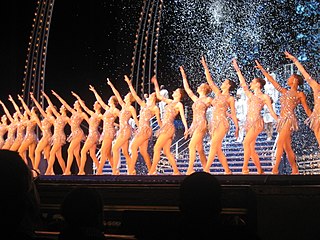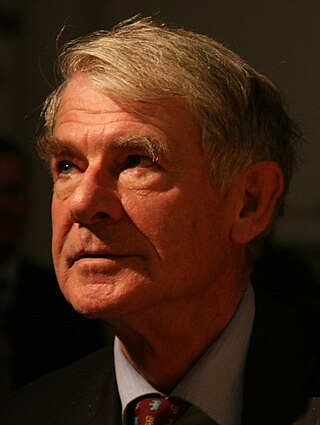Life
Andreas Engel studied medicine and philosophy at Saarland University, Homburg, at the Technical University of Munich, and at the Goethe University Frankfurt in Germany. [1] [2] [3] [4] After his medical exams (German Staatsexamen ), he received his Doctor of Medicine (Dr. med.) from the Technical University Munich in 1987.
In 1987–1995 Engel was a post-doctoral fellow with Wolf Singer at the Max Planck Institute for Brain Research, Frankfurt, Germany. From 1996-2000, Engel headed a research group at the Max Planck Institute for Brain Research which was funded by the Heisenberg Program of the German Research Foundation (DFG). Between fall 1997 and summer 1998, he also was affiliated as a Daimler-Benz Fellow to the Berlin Institute for Advanced Study.
From 2000-2002, he worked at the Jülich Research Centre as head of the Cellular Neurobiology Group at the Institute for Medicine. In 2002, he was appointed to the Chair of Neurophysiology at the UKE. Engel is a member of the Academy of Sciences and Humanities in Hamburg. Since 2011, he is the coordinator of Collaborative Research Centre SFB 936 "Multi-Site Communication in the Brain" (with C. Gerloff, Dept. of Neurology, UKE). [5]
Research
Andreas Engel has become known by his work on the so-called "binding problem". [6] [7] His research focuses on the hypothesis that temporal synchrony serves for dynamic coordination of signals in the brain. In addition to working on the experimental validation of this hypothesis, Engel pursues research on its cognitive and theoretical implications.
As a postdoctoral researcher with Wolf Singer at the Max Planck Institute, Engel was involved in studies that demonstrated the relevance of neural synchrony, in particular of so-called gamma waves, for processing of perceptual information. In particular, the group provided evidence that temporal correlations can serve for the binding of features into coherent sensory representations. [8] In addition to addressing the relevance of synchrony and neuronal oscillations in the visual system, the work of Engel's group yielded evidence for a relation between neural synchrony and visual awareness. In addition, Engel and coworkers contributed to demonstrating a functional role of neural synchrony for sensorimotor coupling.
In the past 15 years, Engel's group has expanded their work to the human brain, using EEG and MEG in combination with source modeling techniques. [9] The results of these studies demonstrate the importance of neuronal oscillations and synchrony for perceptual processing, [10] [11] attention, [12] working memory, [13] decision-making and consciousness. [14] [15] [16] Recent work of the group on the interaction of visual, auditory and tactile systems suggests a role of temporal binding for multisensory integration. [17] The group has developed novel methods for the electrophysiological analysis of resting state network activity. [18] Engel's group also applies these approaches for the study of network malfunction in patients with movement disorders, multiple sclerosis and schizophrenia, in studies on pain, and altered networks after early sensory deprivation. [19] Engel also explores implications of these neurophysiogical results for theories of perception, cognition and action. [20] A major focus of his work are the implications of the studies on neural synchrony for understanding the neural correlates of consciousness. Recent papers address links between neural dynamics and enactive views of cognition, [21] investigating the grounding of cognition in sensorimotor coupling. [22]

Synchronization is the coordination of events to operate a system in unison. For example, the conductor of an orchestra keeps the orchestra synchronized or in time. Systems that operate with all parts in synchrony are said to be synchronous or in sync—and those that are not are asynchronous.
Computational neuroscience is a branch of neuroscience which employs mathematics, computer science, theoretical analysis and abstractions of the brain to understand the principles that govern the development, structure, physiology and cognitive abilities of the nervous system.

Behavioral neuroscience, also known as biological psychology, biopsychology, or psychobiology, is the application of the principles of biology to the study of physiological, genetic, and developmental mechanisms of behavior in humans and other animals.
The consciousness and binding problem is the problem of how objects, background and abstract or emotional features are combined into a single experience.
A gamma wave or gamma rhythm is a pattern of neural oscillation in humans with a frequency between 25 and 140 Hz, the 40 Hz point being of particular interest. Gamma rhythms are correlated with large-scale brain network activity and cognitive phenomena such as working memory, attention, and perceptual grouping, and can be increased in amplitude via meditation or neurostimulation. Altered gamma activity has been observed in many mood and cognitive disorders such as Alzheimer's disease, epilepsy, and schizophrenia.
Brainwave entrainment, also referred to as brainwave synchronization or neural entrainment, refers to the observation that brainwaves will naturally synchronize to the rhythm of periodic external stimuli, such as flickering lights, speech, music, or tactile stimuli.
In the field of computational neuroscience, the theory of metastability refers to the human brain's ability to integrate several functional parts and to produce neural oscillations in a cooperative and coordinated manner, providing the basis for conscious activity.

Neural oscillations, or brainwaves, are rhythmic or repetitive patterns of neural activity in the central nervous system. Neural tissue can generate oscillatory activity in many ways, driven either by mechanisms within individual neurons or by interactions between neurons. In individual neurons, oscillations can appear either as oscillations in membrane potential or as rhythmic patterns of action potentials, which then produce oscillatory activation of post-synaptic neurons. At the level of neural ensembles, synchronized activity of large numbers of neurons can give rise to macroscopic oscillations, which can be observed in an electroencephalogram. Oscillatory activity in groups of neurons generally arises from feedback connections between the neurons that result in the synchronization of their firing patterns. The interaction between neurons can give rise to oscillations at a different frequency than the firing frequency of individual neurons. A well-known example of macroscopic neural oscillations is alpha activity.

Neural binding is the neuroscientific aspect of what is commonly known as the binding problem: the interdisciplinary difficulty of creating a comprehensive and verifiable model for the unity of consciousness. "Binding" refers to the integration of highly diverse neural information in the forming of one's cohesive experience. The neural binding hypothesis states that neural signals are paired through synchronized oscillations of neuronal activity that combine and recombine to allow for a wide variety of responses to context-dependent stimuli. These dynamic neural networks are thought to account for the flexibility and nuanced response of the brain to various situations. The coupling of these networks is transient, on the order of milliseconds, and allows for rapid activity.
Lawrence M. Ward is a neuroscientist and psychophysicist at the Department of Psychology at the University of British Columbia. He studied at Harvard University (AB) and Duke University, where he received his PhD in Experimental Psychology with a minor in mathematics. His current interests are cognitive neuroscience of attention and consciousness with special emphasis on EEG and MEG studies of neuronal synchronization; information transfer between brain regions underlying cognition; psychophysics, biophysics and general theory of stochastic resonance; computational studies of neuronal oscillations and synchronization; neural plasticity; nonlinear dynamical systems theory and its applications in cognitive neuroscience. He co-authored the textbook "Sensation and Perception" with Stanley Coren, and James T. Enns, which went into six editions spanning the period 1978 to 2004.
Repetition priming refers to improvements in a behavioural response when stimuli are repeatedly presented. The improvements can be measured in terms of accuracy or reaction time and can occur when the repeated stimuli are either identical or similar to previous stimuli. These improvements have been shown to be cumulative, so as the number of repetitions increases the responses get continually faster up to a maximum of around seven repetitions. These improvements are also found when the repeated items are changed slightly in terms of orientation, size and position. The size of the effect is also modulated by the length of time the item is presented for and the length time between the first and subsequent presentations of the repeated items.
Recurrent thalamo-cortical resonance is an observed phenomenon of oscillatory neural activity between the thalamus and various cortical regions of the brain. It is proposed by Rodolfo Llinas and others as a theory for the integration of sensory information into the whole of perception in the brain. Thalamocortical oscillation is proposed to be a mechanism of synchronization between different cortical regions of the brain, a process known as temporal binding. This is possible through the existence of thalamocortical networks, groupings of thalamic and cortical cells that exhibit oscillatory properties.
Ralph Mitchell Siegel, a researcher who studied the neurological underpinnings of vision, was a professor of neuroscience at Rutgers University, Newark, in the Center for Molecular and Behavioral Neuroscience. He died September 2, 2011, at his home following a long illness.
A binding neuron (BN) is an abstract concept of processing of input impulses in a generic neuron based on their temporal coherence and the level of neuronal inhibition. Mathematically, the concept may be implemented by most neuronal models including the well-known leaky integrate-and-fire model. The BN concept originated in 1996 and 1998 papers by A. K. Vidybida,

Prefrontal synthesis is the conscious purposeful process of synthesizing novel mental images. PFS is neurologically different from the other types of imagination, such as simple memory recall and dreaming. Unlike dreaming, which is spontaneous and not controlled by the prefrontal cortex (PFC), PFS is controlled by and completely dependent on the intact lateral prefrontal cortex. Unlike simple memory recall that involves activation of a single neuronal ensemble (NE) encoded at some point in the past, PFS involves active combination of two or more object-encoding neuronal ensembles (objectNE). The mechanism of PFS is hypothesized to involve synchronization of several independent objectNEs. When objectNEs fire out-of-sync, the objects are perceived one at a time. However, once those objectNEs are time-shifted by the lateral PFC to fire in-phase with each other, they are consciously experienced as one unified object or scene.

Wolf Joachim Singer is a German neurophysiologist.
Social cognitive neuroscience is the scientific study of the biological processes underpinning social cognition. Specifically, it uses the tools of neuroscience to study "the mental mechanisms that create, frame, regulate, and respond to our experience of the social world". Social cognitive neuroscience uses the epistemological foundations of cognitive neuroscience, and is closely related to social neuroscience. Social cognitive neuroscience employs human neuroimaging, typically using functional magnetic resonance imaging (fMRI). Human brain stimulation techniques such as transcranial magnetic stimulation and transcranial direct-current stimulation are also used. In nonhuman animals, direct electrophysiological recordings and electrical stimulation of single cells and neuronal populations are utilized for investigating lower-level social cognitive processes.
The term posterior cortical hot zone was coined by Christof Koch and colleagues to describe the part of the neocortex closely associated with the minimal neural substrate essential for conscious perception. The posterior cortical hot zone includes sensory cortical areas in the parietal, temporal, and occipital lobes. It is the “sensory” cortex, much as the frontal cortex is the “action” cortex.

Eberhard Erich Fetz is an American neuroscientist, academic and researcher. He is a Professor of Physiology and Biophysics and DXARTS at the University of Washington.
Neural synchrony is the correlation of brain activity across two or more people over time. In social and affective neuroscience, neural synchrony specifically refers to the degree of similarity between the spatio-temporal neural fluctuations of multiple people. This phenomenon represents the convergence and coupling of different people's neurocognitive systems, and it is thought to be the neural substrate for many forms of interpersonal dynamics and shared experiences. Some research also refers to neural synchrony as inter-brain synchrony, brain-to-brain coupling, inter-subject correlation, between-brain connectivity, or neural coupling. In the current literature, neural synchrony is notably distinct from intra-brain synchrony—sometimes also called neural synchrony—which denotes the coupling of activity across regions of a single individual's brain.






